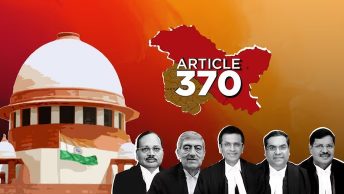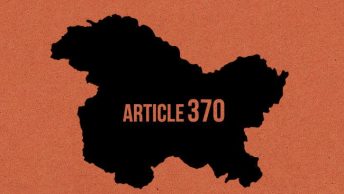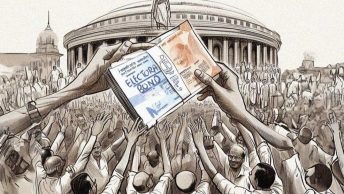With the aim of enabling our readers to keep up with the Supreme Court of India’s day-to-day hearings for the significant case concerning the abrogation of Article 370, LAOT, in collaboration with the Centre for Constitutional Law, NALSAR is bringing you a concise daily summary of what was argued in the Court. This is the summary of Day-6 proceedings and follows in the argumentative continuum surrounding the debated impermanence of Article 370, covering, among other things, thoughts from the perspective of the reactions and activism of the main legislative body, the Constituent Assembly, at the time.
Note: The arguments today proceeded on the finer points of interpreting Article 370 of the Indian Constitution, mainly around the question of external sovereignty, standstill agreements, and the diversity argument as seen in TMA Pai Foundation.
Before the bench convened to hear arguments from the petitioners in In Re: Article 370 petitions today morning, CJI Dhananjaya Y. Chandrachud displayed before the Court the Handbook on Combating Gender Stereotypes which identifies common stereotypes about women in the legal discourse. The handbook aims to be helpful for judicial decision-making and writing.
Rajeev Dhavan, Senior Advocate, representing the Jammu and Kashmir People’s Conference, continued his line of arguments thus. He stressed the importance of dialogue within the Court based on the oral submission, an area where even the US Supreme Court is found lacking. There is more than a question-and-answer routine when it comes to the proceedings; the lawyers have to answer on an ongoing basis what the judges ask or want to know.
The Question of ‘External Sovereignty’
Mr Dhavan recalled the CJI’s reference to Articles 249 and 252 of the Indian Constitution and how the questions around these provisions were necessary to build what he calls the ‘diversity argument.’ They would determine the basis for transformative constitutionalism, basic structure, and other such ideas.
He then came to the status of ‘merger agreements’ as an indication of internal sovereignty and its extent. In the absence of a standstill agreement and a merger agreement, the ruler was absolute. Article 370 thus came as a substitute for these agreements. In the absence of a merger agreement, says Dhavan, diversity in the form of asymmetrical provisions was necessitated.
Article 370 was in place to deal with ‘external sovereignty,’ which the king lost upon signing the agreement. He did not lose internal sovereignty; he was still an absolute monarch. This line of reasoning has been reflected in Prem Nath Kaul vs The State Of Jammu & Kashmir(1959). He refers to the standstill agreement, whose purpose was to have a system in place in the meanwhile, as Mr Dhavan said, and the King did not sign it. The merger agreement, which was also not signed, meant that the Maharaja was absolute. In the absence of both these agreements, sovereignty was not lost thus. According to Dhavan, Article 370 came to fill in that gap. It became a ‘constitutional substitute’ for the standstill and merger agreements. Without Article 370, says Mr Dhavan, “we are lost”.
An excerpt from Prem Nath Kaul v The State of Jammu and Kashmir:
“What form of government the State should adopt was a matter which had to be, and naturally was left to be, decided by the Constituent Assembly of the State. Until the Constituent Assembly reached its decision in that behalf, the constitutional relationship between the State and India continued to be governed basically by the Instrument of Accession. It would therefore be unreasonable to assume that the application of Article 370 could have affected, or was intended to affect, the plenary powers of the Maharaja in the matter of the governance of the State.”
Author’s Notes:
The standstill agreement, the accession agreement, and the merger agreement had different purposes as they defined the relationship between the dominion and the constituent units or states. A standstill agreement was to ensure a smooth transfer of power and a continuance of existing administrative arrangements until the settlement of pending issues was done and new arrangements were made. Dr. Rajeev Dhavan also argued that the signing of the agreement also meant the retention of sovereignty.
The State of Kashmir had announced its intention to negotiate Standstill Agreements with India and Pakistan. Such an agreement was signed with Pakistan but not with India. The object was to provide for the continuance of economic and administrative relations between the undivided State of Kashmir and Pakistan.
Accession and merger agreements also carried different connotations and had different purposes to fulfil. The difference becomes clear from the fact that J&K acceded to the Union of India and did not merge completely. The transfer of lawmaking powers in respect of a few subjects covered under the Instrument of Accession meant that the instrument of merger was not signed. As Article 370 took the shape of the Instrument of Accession, it signified a relationship with a state that did not become a constituent part of the Union of India. For a broader reading of the subject, readers are directed to Zaid Deva’s and Burhan Majid’s essays here and here. Readers can also access a series of articles from the ‘Casting Light on Kashmir’ debate on the Verfassungsblog here.
“Flogging a Dead Horse”- What was lost for J&K
Mr. Dhavan then recalled the question posed by the judges to Senior Advocate Zafar Shah regarding the loss of autonomy after the revocation of Article 370. He also broached Justice Kaul’s question, who had asked whether a dead horse was being flogged. Mr. Dhavan says that Article 370 continues and has to continue to preserve the federation and the conditions under which the federation was created. He comes to the question of diversity, reflected in the Constitution of India, with many nations and cultures. When Mr Dhavan later referred to different agitations for nation-making and autonomy, he referred to the diversity the Constitution registers in matters concerning federalism and democracy. A diversity that is to be treasured, not wished away in the name of uniformity. There are no dead horses to be flogged, said Mr Dhavan.
Articles 3, 356 and the Role of the Legislature
Mr Dhavan referred to the proviso of Article 3, which sets a condition precedent as “the President has to refer the bill to the legislature mandatorily”. Articles 3 and 370 do not tolerate substitutes, said Mr Dhavan. Also, the reorganization exercise cannot be carried out under Article 356. A constitutional amendment subversive of the Constitution itself, if it fails, President’s rule will fail. The entire J&K Reorganization Act emanates from Articles 3 and 4. CJI Chandrachud referred to Article 356(1)(c) and asked if the President has the power to suspend certain provisions of the Constitution during a proclamation under Article 356. Mr Dhavan said the suspension goes beyond supplementing and removes a mandatory requirement. CJI asked if the President, in a proclamation, suspends any provision of the Constitution, whether it will be amenable to challenge on the ground that it is not incidental, and if these words widen the impact of Article 356(1)(b). Mr Dhavan said that this proclamation has to remain within the limits of Article 356 itself. It must relate to 356. Terms like “Necessary” or “desirable” are not carte blanch powers of the President. It has to be given a limited meaning as he could not have done the same to Fundamental Rights, for example, or the suspension of the judiciary. Mr Dhavan said that during the President’s rule, Articles 3 & 4 and Article 370 cannot be invoked as they have conditionalities. Similarly, Article 356 is an exception. The extent of the 2019 proclamation is that it collapses democracy and overrides federalism.
The Bane of the Constitution
CJI asked if the Parliament can enact a law during the subsistence of a proclamation under Art 356 in the exercise of power under Art 246(2) or respect of state list item. Mr Dhavan said that they can pass a law subject to all limitations. However, it must observe the conditionality when it passes a law under Art 3 & 4. He argued that Article 356 is not plenary in nature. It is the bane of the Indian Constitution and has been used and abused to appoint, but there must be some discipline to it. It is certainly not a power to amend the Constitution. These are safeguards for the federal unity of India, as was 370. It is part of the basic structure of federalism in the Constitution. The Governor cannot become the President, and the Legislature cannot become the parliament. This process is subversive to the Constitution.
The Diversity Argument in TMA Pai Foundation
When the Bench was reconvened after lunch, Dhavan referred to TMA Pai Foundation. He quotes the following passages from the case:
“All the people of India are not alike, and that is why preferential treatment to a special section of the society is not frowned upon…”
‘The one billion population of India consists of six main ethnic groups and fifty-two major tribes; six major religions and 6,400 castes and sub-castes; eighteen major languages and 1,600 minor languages and dialects.”
“Each person, whatever his/her language, caste, religion has his/her individual identity, which has to be preserved, so that when pieced together it goes to form a depiction with the different geographical features of India.”
“These small pieces of marble, in the form of human beings, which may individually be dissimilar to each other, when placed together in a systematic manner, produce the beautiful map of India.”
“Each piece, like a citizen of India, plays an important part in making of the whole…even when one small piece of marble is removed, the whole map of India would be scarred, and the beauty would be lost.”
Article 370 as ‘Basic Structure’
Article 370, said Mr Dhavan, being a substitute for a merger agreement, is part of the basic structure. Mr Dhavan insisted on the importance of a merger agreement. He explained how Article 370 substituted both standstill and merger agreements which the Union of India and the State of Jammu and Kashmir had yet to sign. After signing the IoA, the king had not given up his rights. According to Mr Dhavan, Article 370 represents two powerful democratic movements- in the people of India and the people of Kashmir, demanding their Maharaja, which is what he did – he gave up Praja Sabha. Still, he didn’t agree to a constituent assembly that came later. IoA put in the four conditions and fed externally. That is why the distinction between external and internal sovereignty. Since no merger agreement exists, sovereignty may be continued, as laid out in Prem Nath Kaul. Article 370 is thus the repository of the merger agreement read with IoA.
Dr. Rajeev Dhavan concluded his arguments thus, and Senior Advocate Dushyant Dave began his.
An Articulation of Statesmanship
Mr. Dave referred to Article 370 as a “brilliant articulation of statesmanship” on the part of the Constitution’s framers. He referred to the plebiscite, “raids,” the uncertainty of the maharaja, and the “compromise” arrived at in the form of Article 370, which “persuaded people of J&K to accede to India”. Mr. Dave said that Article 370 is a promise which cannot be breached. Tinkering with diversity will lead to destruction.
Mr. Dave submitted that the temporariness of Article 370 is by an object, and once that object is achieved, the President has nothing to exercise. He said that the day J&K Constituent Assembly agreed to it, Article 370 became permanent. He argued that the exercise of powers by the President on the 5th and 6th of August 2019 is nothing but fraud on the Constitution.
Mr Dave referred to Article 356 as a temporary provision and submitted that such a temporary provision cannot make permanent changes to the Constitution. Doing this, according to Dave, meant doing away with democracy and federalism, the basic features of the Constitution. He said breaking states into union territories was not an answer to the insurgency.
The Bench rose for the day.
Aurif Muzafar is a doctoral fellow at NALSAR. He is also a Research Associate for the MK Nambyar SAARC Law Center, NALSAR.
[This post has been edited by Utkarsh Mani Tripathi.]






